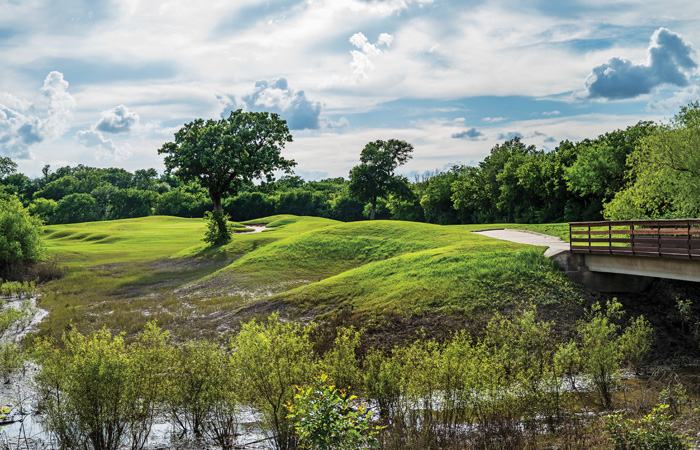Indian Creek Golf Club in Carrollton has always been on the AG radar as one of the premiere public facilities in DFW. With a renovation of the Lakes Course that was completed in 2019, it only reinforced our enjoyment of the property. The renovation of the Lakes, which was handled by Todd Clark, the President of CE Golf Design based out of Kansas City, rejuvenated the Creek’s sister 18, with new fairways, greens and even new cart paths.
Although the course has been open since last year, the official ribbon-cutting was in early May, and many of the city employees, media members and Mr. Clark were on hand to dedicate the updated track.
“We kept the bones of the layout,” Clark said. “We just wanted to update the greens and make some subtle changes to the fairways. We also wanted to improve the drainage to make it more playable after it rains. But we are really pleased with how everything turned out, and we think the regular players here and first-timers will like the new Lakes Course.”
The Lakes Course is a traditional par-72 layout that plays 7,000 yards from the tips. It didn’t get the name “Lakes” for no reason, as there are plenty of water features to command your attention throughout the 18 holes.
The opening hole of the Lakes is a straightforward par-4, playing 378 yards. A slight dogleg right that requires a slight cut off the tee. Players should spot the 150-yard marker and play a tight fade off it to be in optimal position. Some subtle mounding around the green can make for an awkward stance if you don’t hit the putting surface, but overall, it’s a relatively nerve-free way to open your round.
After another par-4 at No. 2, the Lakes presents its first par-5 of the day. This 550-yarder is the first appearance of the noted lakes on this layout. A good aiming point off the tee is over the right half of the visible water on the left. Be aware that the longer hitters can run out of fairway with a slight block right, or they can choose to be more aggressive and take a little more off the pond and leave a shorter second shot. This is one of the larger greens on the opening nine, and there are some bunkers short and right of the green which is a good line for those who choose to lay up.

The first par-3 on the Lakes is No. 4. This one has a subtle two-tiered green that requires a solid iron shot, but playing only 168 from the tips, it shouldn’t be more than a 7- or 8-iron for the better ball striker.
The other par-3 on the Lakes Course is the 180-yard sixth hole. This hole has a pair of bunkers that guard the green and can make for a tough up-and-down. Playing this hole from the blue or white tees takes off some yardage and shouldn’t leave much more than a short iron for the longer players.
No. 7 is the second-toughest hole on the outward nine, playing at a muscular 426 yards. This demanding hole requires a precision tee shot with water down the left and bunkers on the right. The approach will play over water and commands all your attention as you navigate the routing. A green that is 37 yards deep can add or subtract a couple of clubs, and anything short and right will find a watery grave. A short-left miss offers the best opportunity for an up-and-down.

The final two holes on the opening nine are a pair of holes that, if not managed properly, can take a bite out of your scorecard as you turn for the inward nine. No. 8 is a 541-yard par-5 that has plenty of teeth. This tee shot needs to hug the right center of the fairway, leaving a manageable second shot. Most players will need to lay up, but beware of the pinched fairway in the layup zone and the water on the right. Leaving an ideal wedge number here is at a premium to give players a chance to score.
The final hole of the opening nine is the most difficult hole on the Lakes Course. This bully of a par-4 plays 439 yards and usually heads into a prevailing southerly breeze. Water down the left side gets your attention as you stick a peg in the ground. A right center fairway tee shot leaves an optimum angle, but there is a large greenside sand trap that can swallow golf balls and make for a near impossible par. This is a hole where a center-of-the-green play followed by a two-putt par is your friend.
The first couple holes on the back nine are tough fairways to find. Although short, No. 10 is narrow, but playing a tee shot just right of the 150-yard marker is a smart play. A two-tiered green means wedge shots need to be precise or players can run the risk of a three-putt bogey.
The par-5 11th hole is also a narrow tee shot, with trees framing the hole on both sides. This hole should generally play a little down-fan, so it can play less than the 552 yards you see on the scorecard.
It’s a scorable couple of holes to start the back nine after a tough finish to the front. No. 12 holds a bit of a surprise beyond the visible trees in a water feature down the right. The longer hitters can easily reach it with a cut that maybe wiggles a little further right than intended. While driver can be played, some may choose a fairway finder 3-metal to eliminate the risk of ending up in the water. Several greenside bunkers need to be avoided on the approach shot. Be mindful that with a front pin, anything long can leave a tough two-putt.

The final trio of holes on the Lakes feature two of the four hardest holes on the course bookending the easiest. No. 16 is a 441-yard par-4 which plays as the No. 2 handicap on this layout. It is a tough driving hole, with the longer hitters taking a bit off the dogleg, but there is water left of the fairway, so be mindful to stay clear of it.
The 17th is rated as the easiest hole on the course, playing at just 162 yards. There isn’t much to this one, but there are some bunkers guarding the green. The one on the front right can be a tall order to save par, and the one on the far left isn’t necessarily in play. The middle greenside bunker is short of the putting surface and isn’t the worst place to be. Note that there is water about 30 yards over the green, so any ball that carries the surface can catch a downslope and end up near or in the hazard.
The final test on the Lakes Course is a par-4, measuring at 426 yards. This No. 4 handicap usually will play back into the south wind. A good line is just left of the 150-yard marker to leave a good angle in. There are a pair of ponds that guard the hole, one of which can collect shots short of the green on the approach. This hole usually plays into the wind; the club selection on the second shot is paramount. It is a tough finishing hole, and one that can deep-six a good round with improper club selections.
The Creeks Course at Indian Creek is undoubtedly one of the most interesting layouts you will find in local municipal golf. One of the first things that strikes you about the Creeks is the abundance of undulations around the fairways and greens. They aren’t tremendously severe, but they can take marginal shots and either improve them or just destroy them. Catch on one side and be fine or even better; catch the wrong side, and you will need to have your scramble britches on all afternoon. It can make for some good fun, or some extra hair-pulling, depending on which way those 50/50 balls careen.
It is called the Creeks Course because the Elm Fork of the Trinity River makes several appearances throughout the round, with some of its small tributaries coursing their way throughout the 18 holes. Again, like its sister layout, it is a par-72 design.

Right away on No. 1 you can see the mounding I am referring to. Moguls line each side of the fairway, helping marginal tee shots drift back into the fairway. Some great bunkering near the green makes this approach visually tough. And a deep green means players need to add a club or two if the pin is in the back.
The second hole on the Creeks course features a prominent tree that sits in the left center of the fairway. Now, usually, I am not a fan of trees in the fairway because I detest designers that punish good golf shots, but this one if far enough away from the tee that, while it is in play, it can either be carried by the longer hitters or navigated around by the shorter players. It’s truly an interesting hole, and the green complex is bizarre with severe mounding on the left and two tiers to deal with on the approach.
The opening par-3 on the Creeks appears at No. 5. This 168-yard hole features a diabolical green that requires a precise iron distance. A bunker on the right makes an up-and-down near impossible. Depending on pin placement, this hole can be a real bear.
One of the more intriguing holes on this layout is the par-5 sixth. Playing 514 yards, this is the only split fairway on both courses. A narrower right landing area leaves players a better chance to get home in two, while the left side play is more forgiving, but almost assures a layup and a wedge third.
No. 7 is the No. 1 handicap hole on the course, with water on the left and a fairway bunker on the right. Psychologically, the water will leave players bleeding balls into the right fairway bunker, leaving a lengthy second and a tough par. There’s a reason it’s the No. 1 handicap hole.
The inward nine on the Creeks course has plenty of character and one of the most interesting sets of holes you are going to find anywhere in DFW. After the par-4 10th, you come to the 584-yard par-5. Mounding down either side along with some bunkering add some visual intimidation, and the fairway narrows a bit where the bombers will land their tee shots. Another bunker guards the layup zone, and a trap guards the green short and left. If you do lay up, make sure you favor the right to leave you the best angle in.
No. 12 is where things on the Creeks course start to get a bit wheels-off. And I certainly don’t mean that in a bad way, of course … but the finish from 12-18 isn’t like anything else you have played. I guarantee it.

The 12th is a par-3 that plays a whopping 260 yards from the tips. Yes, you read that right: 260 yards. The tee shot is carried over a deep waste area, and there is a tree that juts out from the right to narrow your field of vision a bit. A huge bunker guards this 42-yard-deep green on the right. It’s just a brute of a par-3 and one that is a primary reason to pick the appropriate tees when you arrive on No. 1.
No. 13 is another gorgeous hole that runs right along the Elm Fork of the Trinity. Anything bleeding right will find the water, so it’s best to favor the left side and leaving yourself near the 150-yard marker. Be wary of the tabletop green on this one, as it can be hard to hold the putting surface.
After the behemoth 12th, the second par-3 of the nine is as simple as it gets. At just 131 yards, No. 14 is a great chance to notch that first ace or stick one close for a birdie, to get one back you likely gave up at the 12th.

After a short par-4 at 15, the 16th opens a final stretch that can be really tough, especially if the wind is blowing. The 601-yard par-5 is the longest on either course, and features that Elm Fork all down the right side. The tendency here will be to miss left to avoid it, and that can make this a very long hole. Getting home in two is reserved for only the top of the food chain mutants, as most of us will lay up and leave something manageable for the third. It’s a big-boy hole and one that can really benefit the better players.
The final hole of the Creeks adventure is a long par-4 that has almost zero landing area off the tee. Water left and right narrow the landing area down to seemingly nothing. As if finding the fairway wasn’t tough enough, should you pull it off, players will be left with a long- or mid-iron to a green that is surrounded by some of the most significant mounding on the course. This is a whopper of a final hole on a course chock-full of fun, danger and some of the most interesting design elements you will find on the public links here in the Metroplex. It is a true pleasure to play, and a course you should really see for yourself.
Although the carts at Indian Creek can be a little noisy, being gas-powered, they come with GPS, which is immensely helpful for first-timers or those who don’t have a rangefinder. They also have speaker that will link to your phone if you want to soak in some tunage while you relax and play. In addition, if you are trying to work a little during your round and your phone charge begins to bleed out, you can use the USB port in the cart to keep your device juiced.
The clubhouse at Indian Creek offers everything you need for a day on the links. There are plenty of attire, gloves, balls etc., in case you need to stock up before you head out. The Arrowhead Grill has large bay windows to allow for some natural light as you enjoy a cold beverage at the turn or post-round. There are also plenty of TVs to take in some highlights or watch the PGA Tour action of the week as you enjoy any number of items from the menu. Breakfast burritos or sandwiches are offered if you want to fuel up before the morning round, or you can go for one of their sandwiches or burgers. I checked out the Nick’s Crispy Chicken sandwich after my afternoon on the course. It is a crispy fried chicken breast served with chipotle mayo and pickles. I tricked it out for a couple extra bucks with some pepper jack cheese and some bacon. It was a great accompaniment to the ice-cold beer I threw down as I added up the scorecard. There is a running beverage cart, as well. for all your on-course refreshment needs.
At the end of the day, for a great, affordable daily fee property, Indian Creek has it all. Whether you’re looking for a more traditional, straightforward layout in the Lakes Course, or a more whimsical, thought-provoking track on the Creeks side, Indian Creek boasts 36 magnificent holes to stretch your golfing dollar.
Indian Creek Golf Club
1650 West Frankford Road
Carrollton, TX 75007
972-466-9850
www.indiancreekgolfclub.com